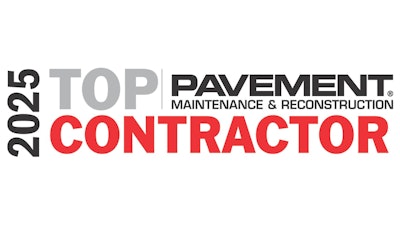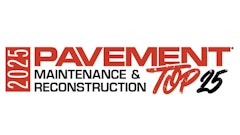
Over the 10-year period, there are notable fluctuations in the sales figures for pavement repair services, reflecting both market conditions and the broader economic environment. From TC 2015 to TC 2016, the sector saw a slight decline of approximately 5.2%, with sales dropping from $269 million to $255 million.
However, this decline was followed by a significant drop of 35.3% in TC 2017, when sales fell to $165 million. This sharp decrease likely reflects a variety of challenges, such as regional market slowdowns, supply chain disruptions, or reduced infrastructure spending during that period. Despite this dip, the sector recovered in TC 2018, with sales rebounding to $265 million, nearly matching 2015 levels.
 The graph above visualizes the Pavement Repair Only Sales for the Top 50 Contractors from 2015 to 2025.
The graph above visualizes the Pavement Repair Only Sales for the Top 50 Contractors from 2015 to 2025.
The period from TC 2019 to TC 2021 saw moderate sales fluctuations, with a slight decline from $265 million in 2018 to $209 million in 2019, followed by a recovery to $217 million in 2020, likely driven by ongoing infrastructure needs despite the pandemic. In TC 2021, sales continued to decline to $205 million, possibly due to the lingering effects of the COVID-19 pandemic and its impact on construction and maintenance budgets.
However, TC 2022 marked a strong recovery, with sales reaching $248 million—an increase of nearly 21% from 2021, as demand for pavement repair services surged, possibly driven by post-pandemic recovery and government infrastructure initiatives. The 2023-2025 period saw a remarkable surge in sales, peaking at $557 million this year, a 76.5% increase from TC 2024, and marks the highest point for this sector ever recorded.
This sharp rise is indicative of a robust recovery and possible expansion in the infrastructure and repair sectors, likely spurred by increasing investments in road maintenance and repair projects. For the decade, the annual growth rate is an incredibly strong 7.55%, which is the highest growth rate of all four Top Contractor categories. People are using their funds to fix what they have, and this is supported by the fact that across our entire survey, not just the Top 50, 80% of revenue for all contractors came from work on existing pavements, and only 20% from new construction.
This shift is consistent with the ongoing recovery in infrastructure spending and possibly federal or state-level initiatives targeting aging infrastructure in many regions. The large growth in 2025, following a relatively slower period, demonstrates the potential volatility in the sector, but also suggests that the market for pavement repair is improving significantly after the challenges posed by the pandemic and the disruptions in the early 2020s.
Total Sales Pavement Repair Top 50
The total gross sales for the Top 50 Pavement Repair contractors came in at $1.698 billion, a growth spurt of $155 million, or 10.05% up from the TC 2024 total of $1.543. It is also a slight improvement over the previous high from TC 2023 of $1.672 billion. Here are the gross revenues going back five years. You can see that the trend is really positive, representing a growth rate of 14.03% over half a decade.
 The Total Sales Revenue for the Top 50 Pavement Repair Contractors from 2021 to 2025
The Total Sales Revenue for the Top 50 Pavement Repair Contractors from 2021 to 2025
The Pavement Repair category continues to be strong, I believe, because of the influx of federal dollars from the previous Administrations focus on infrastructure spending. That money may start at the top, going to road builders and State DOTs, but it eventually does trickle down, unlike in the corporate sector.
It will be fascinating to see what happens as we approach the end of the funding period for IIJA, which provided billions in spending for projects, which concludes with CY 2026.
Profit Margins
So, I'm kind of confused by this years profit margin breakdown, and it's starting to make me wonder if I shouldn't have fiddled with the system as it was. I do that alot, and sometimes I just can't help myself. But last year it seemed to redistribute the graph in a way that made sense. The figures weren't as top heavy.
We shifted them just slightly again this year, though not as major, but the same trend has emerged as in the other categories. The middle is getting squeezed out. You're either in the top or the bottom. However, it is important to know that before we made the change, in TC 2022 the highest profit margin range contained 56% of contractors. So even though the top percentile has gone back up, it still is a better distribution that it was before:
- 40% of contractors (20) reported profit margins greater than 20%, up 4% from last year.
- 12% (6) ranked in the 16-20% range, a decrease of 6%.
- That means 52% were in the highest range of profits, compared to TC 2023 which saw 56% in the above 15% range.
- 18% of contractors (9) reported profits in the 10-15% range, a drop of 10% from last year! That's a huge change.
- 30% of contractors (15) fell into the 6-9% profit range, nearly doubling from last year with an increase of 14%.
- 0% were in the lowest bracket at 5% or less profit margins.
This might be a first. There were no contractors in the Top 50 of Pavement Repair to have below a 6% profit margin.
Types of Work
- 58% (29) of the Pavement Repair Top 50 completed work on driveways at an average rate of 13% of their job mix composition
- 28% (14) of this Top Contractor category completed highway work, the lowest of all list groups, at an average rate of 21%
- 100% (50) of the contractors completed some parking lot work at an average rate of 63%, a slight dip from last year.
- 80% (40) of contractors also did residential street or roadwork at an average rate 24% of the job mix
Types of Clients
- All 50 of the Pavement Repair Top 50 completed work for commercial and/or industrial customers at an average rate of 55% of client mix composition
- 88% (44) of contractors on the list completed some municipal work at an average rate of 18% of client mix, a jump of 10%!
- 94% (47) of the Top 50 did work for multi-family residence or HAOs at an average rate of 22%, which were the same exact stats from TC 2024.
- 54% (27) of companies worked for single-family residence at an average rate of 10% of client mix
- 16% (8) did work for other unspecified types of clients at a rate of 6% of their work mix.
Number of Customers
Another interesting mirror of the overall trends this year, a vanishing of the middle. Percentages are representative of the Top 50.
- More than 400 (24%)
- 301 - 400 (4%)
- 201 - 300 (18%)
- 151 - 200 (16%)
- 100 - 150 (16%)
- Fewer than 100 (22%)
Number of Projects
A wholly different distribution here, where it seems that there is just a lot of work available out there, and everyone is getting a piece of the pie.
- More than 400 (50%)
- 301 - 400 (18%)
- 201 - 300 (8%)
- 151 - 200 (2%)
- 100 - 150 (16%)
- Fewer than 100 (6%)
Fleet Replacement
This distribution doesn't surprise me, as the trend for the last three years since I started as the editor, has shown this keeps pushing higher. Expect a change for this question next year to better represent the costs of modern equipment.
- 4% (2) would need less than $250,000
- 4% (2) of the Pavement Repair Top 50 said it requires between $250K - $500K to fully replace their fleets
- 4% (2) said that it would require twice that, between $500K - $1 million
- 24% (12) stated that it would take between $1 million - $2 million
- The remaining 64% (32) said it would need more than $2 million to fully replace their fleets




















